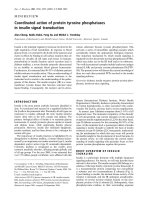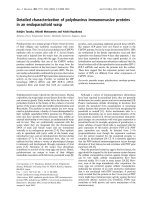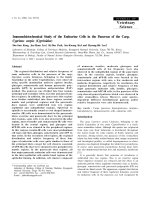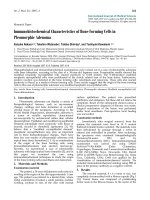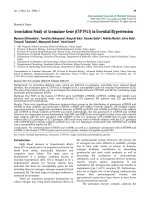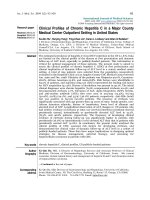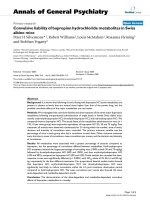Báo cáo y học: " Immunohistochemical Characteristics of Bone Forming Cells in Pleomorphic Adenoma" ppt
Bạn đang xem bản rút gọn của tài liệu. Xem và tải ngay bản đầy đủ của tài liệu tại đây (844.28 KB, 3 trang )
Int. J. Med. Sci. 2007, 4
264
International Journal of Medical Sciences
ISSN 1449-1907 www.medsci.org 2007 4(5):264-266
©Ivyspring International Publisher. All rights reserved
Research Paper
Immunohistochemical Characteristics of Bone Forming Cells in
Pleomorphic Adenoma
Keisuke Nakano
1, 2
, Takehiro Watanabe
1
, Takako Shimizu
2
, and Toshiyuki Kawakami
1, 2
1. Hard Tissue Pathology Unit, Matsumoto Dental University Graduate School of Oral Medicine, Shiojiri, Japan
2. Hard Tissue Pathology Unit, Matsumoto Dental University Institute for Oral Science, Shiojiri, Japan
Correspondence to: Keisuke Nakano, DDS, PhD, Assistant Professor, Hard Tissue Pathology Unit, Department of Hard Tissue Research,
Matsumoto Dental University Graduate School of Oral Medicine, 1780 Hirooka-Gobara, Shiojiri, 399-0781 Japan. Tel: +81-(0)
263-51-2035; Fax: +81-(0) 263-51-2035; E-mail:
Received: 2007.09.06; Accepted: 2007.10.15; Published: 2007.10.16
Histopathological and immunohistochemical examinations were carried out in a case of pleomorphic adenoma
with bone formation, occurring in the chin of a 34-year-old Japanese man. Examination results showed the
modified neoplastic myoepithelial cells reacted positively to S-100 protein. The S-100-positive modified
neoplastic myoepithelial cells were proliferated in the closely related area of the bone tissue. Furthermore,
positive reaction was detected in the bone forming cells: osteoblasts and osteocytes. These cells also reacted
positively to Runx2 as a marker of bone forming cells. These results suggest that the origin of the bone forming
cells in this case of pleomorphic adenoma was modified neoplastic myoepithelial cells.
Key words: Bone forming cells, Immunohistochemical characteristics, Pleomorphic adenoma, Modified myoepithelial cell,
Trans-differentiation
1. Introduction
Pleomorphic adenomas can display a variety of
histopathological features, such as myxomatous
changes, cartilage and bone formation in so-called
stromal tissue of the neoplasms. According to the
World Health Organization, pleomorphic adenoma is
a tumor of variable capsulation, characterized
microscopically by architectural rather than cellular
pleomorphism. Epithelial and modified myoepithelial
elements intermingle most commonly with tissue of
mucoid, myxoid or chondroid appearance [1]. We
believe that a “modified myoepithelial element”
(neoplastic myoepithelium) may play an important
role in these histopathological changes. There have
been few case reports of pleomorphic adenoma with
typical bone tissue formation [2, 3, 4], or examinations
of the origin of the bone forming cells, using
immunohistochemistry and electron microscopy.
Recently, we experienced a case of pleomorphic
adenoma with large typical bone formation [5], and in
this paper we examined the case using
immunohistochemical techniques to study the origin
of the bone forming cells (osteoblasts and osteocytes).
2. Materials and Methods
Examination material
The patient, a 34-year old Japanese male noticed a
swelling at the region of his chin approximately 1 year
ago. The patient was referred to a dental clinic, where
initial examination revealed a small painless nodular
swelling, soybean in size, of the chin with normal
surface epithelium. The patient was prescribed
antibiotics and analgesics, but these did not relieve his
symptoms. Based on the subsequent clinical course, a
clinical preoperative diagnosis of fibroma was made.
Surgical enucleation of the lesion was performed
under local anesthesia. Post-operative local healing
was uneventful.
Examination methods
Immediately after surgical removal, from the
patient, the materials were fixed in 10 % neutral
buffered formalin fixative solution. The materials were
then dehydrated by passage through a series of
ethanol and embedded in paraffin. After sectioning,
the specimens were examined histopathologically
(hematoxylin-eosin: HE) and by
immunohistochemistry (IHC). Immunohistochemical
examination was carried out using DAKO
EnVision
TM
+Kit-K4006 (Dako Cytomation,
Copenhagen, Denmark) and 2 monoclonal antibodies:
S-100 (NCL-S100p; Novo, Newcastle, UK), Runx2
(M70: sc-107589; Santa Cruz Biotechnology Inc, Santa
Cruz, California, USA). DAB was applied for the
visualization of immunohistochemical activity. We
included immunohistochemical staining using PBS in
place of the primary antibody as a negative control.
3. Results
The resected material, 8 x 6 x 6mm in size, was
completely circumscribed with a fibrous capsule [Fig 1
(1)]. Tumor tissue was composed of proliferating
tumor nests in the fibrous tissues. In the center of the
Int. J. Med. Sci. 2007, 4
265
tumor mass, there were some enlarged cystic lumens.
The proliferating neoplastic cells consisted of ductal
cells, sometimes showing formation of lumens, and
modified myoepithelial cells, appearing in the outer
layer. Some lumens had eosinophilic material [Fig 1
(2)]. In the area of so-called stromal tissue,
spindle-shaped cells proliferated in close or in coarse,
and myxomatous lesions were observed. Furthermore,
spindle-shaped and oval-shaped neoplastic cells
proliferated in the so-called stromal tissues [Fig 1 (3)].
Bone formation was observed in the area near the
fibrous capsule. The bone had marrow-like tissue in
the center of the bone tissue mass. The bone tissue was
composed primarily of compact bone. The osteoblasts
were typically arranged in the outer surface of the
bone tissue. In contrast, on the side of marrow-like
tissue, arrangements of both osteoblasts and
osteoclasts were observed [Fig 1 (4)]. In some
instances, there were remodeling lines which were
deeply stained with hematoxylin.
Immunohistochemically, S-100 protein-positive
products were detected in the cytoplasm of modified
neoplastic cells in the neoplastic cell nests.
Spindle-shaped or oval-shaped modified neoplastic
myoepithelial cells, in the so-called stromal tissue,
reacted positively to S-100 protein [Fig 1 (5)]. The S-100
positive cells coarsely proliferated in most stromal
tissues, close to the bone tissues. Furthermore, the
S-100 positive products were detected in the cytoplasm
of some osteoblasts and osteocytes [Fig 1 (6)]. The
osteoblasts and osteocytes were both positive to Runx2
[Fig 1 (7)].
4. Discussion
The histopathological pattern of pleomorphic
adenoma is variable. Although there are some case
reports of bone formation in pleomorphic adenoma [2,
3, 6-9], Shigeishi et al. [3] noted that bone formation in
pleomorphic adenoma is a rare finding, and only
several cases have been reported. Yates and Paget [9]
described a case of pleomorphic adenoma of the
submandibular gland with trabecular bone formation,
and the bone was formed by endochondral
ossification. On the other hand, Lee et al. [7] mentioned
in their case report of pleomorphic adenoma with bone
formation that the bone matrix was deposited directly
by the metaplastic myoepithelial cells rather than by
endochondral ossification. Hamakawa et al. [6] noted
that bone tissue in pleomorphic adenoma was formed
mainly by direct deposition of the osteoid tissue
produced by the modified myoepithelial cells and via
partial endochondral ossification mode. However,
Takeda and Yamamoto [8] discussed bone formation
mechanisms according to the histopathological
findings of their bone forming pleomorphic adenoma
case. In their report, the bone tissue was formed in the
so-called stromal tissue and was surrounded by
stromal fibrocytes and parenchymal epithelial cells,
while no myxochondroid or chondral tissue was
evident in the surrounding tissue. They discussed how
the histopathological features suggested the possibility
of stromal metaplasia of undifferentiated mesemcymal
cells to osteoblast. Furthermore, Shigeishi et al. [3]
have discussed their case with bone formation, and
concluded the possibility of endochondral ossification
according to the histopathological features of bone
tissue formed within areas of chondral tissue. Arai et
al. [2] discussed how the origin of bone-forming cells
took place in the metaplasia of the true-stromal
undifferentiated cells.
There are two theories in the origin of the
bone-forming cells osteoblast and osteocytes: one from
modified myoepithelial cells, and other from
undifferentiated mesemchymal cells of true stromal
tissue, including the possibility that one of the
metaplastic factors was neoplastic cells producing
BMP. Therefore, we sought to determine the origin of
the bone forming cells in our present case using
immunohistochemical technique with S-100 protein as
a marker of myoepithelial cells, and Runx2 as a marker
of bone forming cells. S-100 protein is a well-known
marker of modified neoplastic myoepithelial cells of
pleomorphic adenoma. Since there have been no
report regarding the relationship between the
modified myoepithelial cells and bone forming cells
(osteoblasts and osteocytes) appearing in pleomorphic
adenomas, we examined the relationship between the
two.
In the present case, the bone forming cells
showed positive immunohistochemical reaction to
S-100. S-100 reaction appeared in the modified
myoepithelial cells in the nests and spindle-shaped or
oval-shaped modified myoepithelial cells of the
stromal tissues. Furthermore, the cyto-proliferation of
these modified myoepithelial cells continued to the
bone forming cells, which reacted to Runx2, a
well-known osteoblastic maker. Therefore, the results
strongly suggest that the bone forming cells
(osteoblasts and osteocytes) originated from the
modified (neoplastic) myoepithelial cells. This means
the metaplasia (trans-differentiation) took place
between the epithelial and mesemchymal tissues,
myoepithelium and bone forming cells (osteoblast and
osteocytes), although there is supposedly no
metaplasia between the epithelial cells and
mesemchymal cells according to textbooks of
pathology.
In addition, the bone tissue formed in the
pleomorphic adenoma, revealed reversal line
indicated by deeply-stained hematoxylin structure
with osteoclasts and osteoblasts. This finding suggests
that bone formation occurred over a long period of
time.
In conclusion, our present study morphologically
confirms that the origin of the bone forming cells in
this case of pleomorphic adenoma was modified
neoplastic myoepithelial cells. This finding strongly
suggested that the trans-differentiation took place
between the epithelial and mesemchymal tissues.
Conflict of interest
The authors have declared that no conflict of
Int. J. Med. Sci. 2007, 4
266
interest exists.
References
1. Eveson JW, Kusafuka K, Stenman G, Nagano T. Pleomorphic
adenoma. In: Barnes L, Eveson JW, Reichart P, Sidransky D, ed.
World Health Organization Classification of Tumours.
Pathology & Genetics Head and Neck Tumours. Lyon: IARC
Press; 2005: 254-258.
2. Arai Y, Sakuma Y, Yokozawa S, Uchida M, Fujita H, Nonaka H.
A case of pleomorphic adenoma with remarkable bone
formation. Jpn J Oral Surg 2003; 49: 272-275.
3. Shigeishi H, Hayashi K, Takata T, Kuniyasu H, Ishikawa T,
Yasui W. Pleomorphic adenoma of the parotid gland with
extensive bone formation. Pathol Int 2001; 51: 883-886.
4. Thackray AC, Lucas RB. Tumors of the major salivary glands.
Washington DC: Armed Forces Institure of Pathology. 1983:
16-39.
5. Watanabe T, Shimizu T, Kou H, Okafuji N, Kurihara S,
Kawakami T. A case of pleomorphic adenoma with bone
formation. J Matsumoto Dent Univ Soc (Matsumoto Shigaku)
2006; 32: 133-137.
6. Hamakawa H, Takarada M, Ito C, Tabioka H. Bone-forming
pleomorphic adenoma of the upper lip: report of a case. J Oral
Maxillofac Surg 1997; 55: 1471-1475.
7. Lee KC, Chan JK, Chong YW. Ossififying pleomorphic adenoma
of the maxillary antrum. J Laryngol Otol 1992; 106: 50-52.
8. Takeda Y, Yamamoto H. Stromal bone formation in pleomorphic
adenoma of minor salivary gland origin. J Nihon Univ Sch Dent
1996; 38:102-104.
9. Yates PO, Paget GE. A mixed tumor of salivary gland showing
bone formation, with a histochemical study of the tumor
mucoids. J Pathol Bacteriol 1952; 64: 881-888.
Figures
Figure 1. (1) Tumor tissue is completely circumscribed with a
fibrous capsule (HE, x 10). (2) The proliferating neoplastic cells
consisted of ductal
cells, sometimes
showing formation of
luminal formation with
or without eosinophilic
material (HE, x 30). (3)
Spindle-shaped and
oval-shaped neoplastic
cells proliferating in
so-called stromal tissues
(HE, x 50). (4) Bone
formation is observed in
the tumor tissue. The
bone has marrow-like
tissue in the center of
the bone tissue mass
(HE, x 100). (5) S-100
positive products are
detected in the neoplas-
tic cells. Spindle-shaped
or oval-shaped modified
neoplastic myoepithe-
lial cells react positively
to S-100 protein (IHC,
S-100, x50). (6) In some
cases, S-100 positive
products were detected
in the cytoplasm of
osteoblasts (IHC,
S-100, x50). (7) The
osteoblasts and osteo-
cytes are both positive
to Runx2 (IHC, Runx2,
x50).

